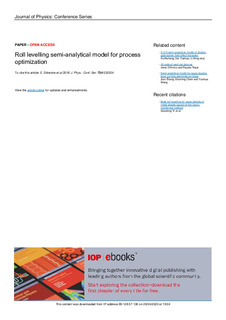Title
Roll levelling semi-analytical model for process optimizationAuthor (from another institution)
Publication Date
2016Other institutions
Koniker S.Coop.Fagor Arrasate, S.Coop.
Version
Published versionDocument type
Conference ObjectConference ObjectLanguage
EnglishAccess
Open accessPublisher’s version
http://dx.doi.org/10.1088/1742-6596/734/3/032034Published at
Journal of Physics: Conference Series Vol. 734. N. artículo 032034, 2016Publisher
IOPKeywords
Analytical models
Computation theory
High strength steel
Machine design ... [+]
Computation theory
High strength steel
Machine design ... [+]
Analytical models
Computation theory
High strength steel
Machine design
Metal forming
Numerical model
Optimization
Process control
Residual stresses
Sheet metal
Strip metal
Wear of materials [-]
Computation theory
High strength steel
Machine design
Metal forming
Numerical model
Optimization
Process control
Residual stresses
Sheet metal
Strip metal
Wear of materials [-]
Abstract
Roll levelling is a primary manufacturing process used to remove residual stresses and imperfections of metal strips in order to make them suitable for subsequent forming operations. In the last years ... [+]
Roll levelling is a primary manufacturing process used to remove residual stresses and imperfections of metal strips in order to make them suitable for subsequent forming operations. In the last years the importance of this process has been evidenced with the apparition of Ultra High Strength Steels with strength > 900 MPa. The optimal setting of the machine as well as a robust machine design has become critical for the correct processing of these materials. Finite Element Method (FEM) analysis is the widely used technique for both aspects. However, in this case, the FEM simulation times are above the admissible ones in both machine development and process optimization. In the present work, a semi-analytical model based on a discrete bending theory is presented. This model is able to calculate the critical levelling parameters i.e. force, plastification rate, residual stresses in a few seconds. First the semi-analytical model is presented. Next, some experimental industrial cases are analyzed by both the semi-analytical model and the conventional FEM model. Finally, results and computation times of both methods are compared. [-]
xmlui.dri2xhtml.METS-1.0.item-sponsorship
Gobierno Vascoxmlui.dri2xhtml.METS-1.0.item-projectID
GV/Programa de apoyo a la I+D Empresarial Hazitek 2017/ZL-2017-00316/CAPV/Nueva aplanadora de vida elevada para el aplanado de materiales ultrarresistentes/LEUNGORCollections
The following license files are associated with this item:






















